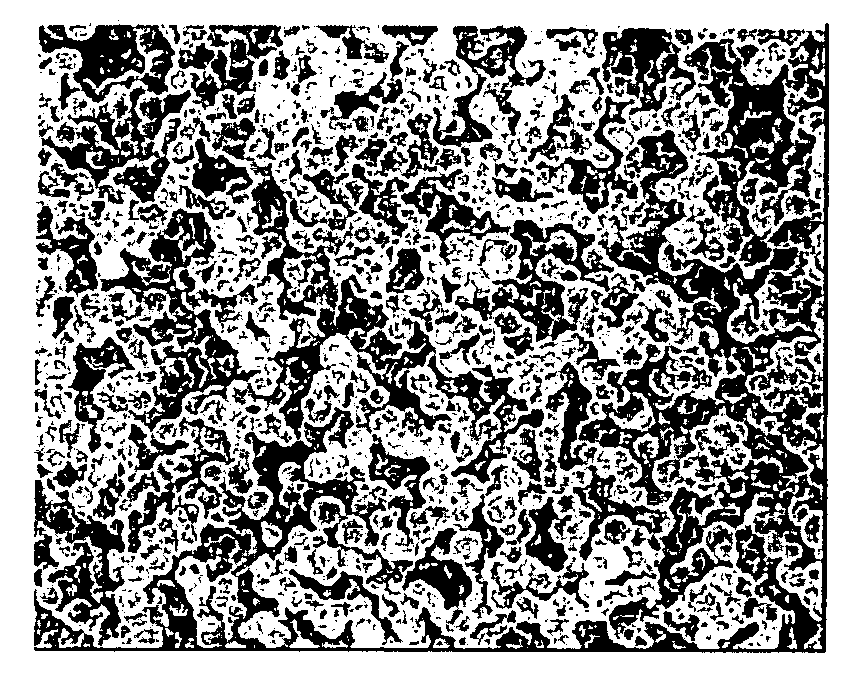Porous Cured Epoxy Resin
- Summary
- Abstract
- Description
- Claims
- Application Information
AI Technical Summary
Benefits of technology
Problems solved by technology
Method used
Image
Examples
example 1
[0063]22 g of a bisphenol A epoxy resin (Japan Epoxy Resins Co., Ltd., trade name: Epikote 828) was dissolved in 36 g of methoxymonopropylene glycol acetate (Daicel Chemical Industries Ltd.) to prepare an epoxy resin / porogen solution. Then, 6 g of bis(4-aminocyclohexyl)methane (New Japan Chemical Co., Ltd., trade name: Wandamine HM) was dissolved in 36 g of methoxymonopropylene glycol acetate to prepare a hardener / porogen solution.
[0064]The epoxy resin / porogen solution and the hardener / porogen solution were heated to 60° C., defoaming in a vacuum, and then mixed in a mixer, and the mixed solution was poured in a metal mold of 20 mm in diameter which was heated at 120° C., and held for 10 h as it was. After cooling, the cured material was taken out, immersed in ethanol of 60° C. for 20 h to remove the porogen, and post-cured at 160° C. for 5 h. The content of the aromatic-ring-derived carbon atoms, the porosity, the average pore diameter and the logarithmic distribution width at the ...
example 2
[0065]22 g of a hydrogenated bisphenol A epoxy resin (Dainippon Ink and Chemicals, Inc., trade name: Epiclon 7015) was dissolved in 36 g of methoxymonopropylene glycol acetate (Daicel Chemical Industries Ltd.) to prepare an epoxy resin / porogen solution. 6 g of 4,4′-diaminodiphenylmethane (Tokyo Chemical Industry Co., Ltd.) was dissolved in 36 g of methoxymonopropylene glycol acetate to prepare a hardener / porogen solution. Hereinafter, as in Example 1, a porous cured epoxy resin was fabricated; and the measurement results of the content of the aromatic-ring-derived carbon atoms, the porosity, the average pore diameter, the logarithmic distribution width at the height of ¼ of the maximum of the differential pore distribution measured by the mercury penetration method, and the distribution coefficients, are shown in Table 1.
example 3
[0066]11 g of a bisphenol A epoxy resin (Japan Epoxy Resins Co., Ltd., trade name: Epikote 828) and 11 g of a hydrogenated bisphenol A epoxy resin (Dainippon Ink and Chemicals, Inc., trade name: Epiclon 7015) were dissolved in 36 g of methoxymonopropylene glycol acetate (Daicel Chemical Industries Ltd.) to prepare an epoxy resin / porogen solution. Then, 3 g of bis(4-aminocyclohexyl)methane (New Japan Chemical Co., Ltd., trade name: Wandamine HM) and 3 g of 4,4′-diaminodiphenylmethane (Tokyo Chemical Industry Co., Ltd.) were dissolved in 36 g of methoxymonopropylene glycol acetate to prepare a hardener / porogen solution. Hereinafter, as in Example 1, a porous cured epoxy resin was fabricated; and the measurement results of the content of the aromatic-ring-derived carbon atoms, the porosity, the average pore diameter, the logarithmic distribution width at the height of ¼ of the maximum of the differential pore distribution measured by the mercury penetration method, and the distribution...
PUM
| Property | Measurement | Unit |
|---|---|---|
| Length | aaaaa | aaaaa |
| Fraction | aaaaa | aaaaa |
| Fraction | aaaaa | aaaaa |
Abstract
Description
Claims
Application Information
 Login to View More
Login to View More - R&D
- Intellectual Property
- Life Sciences
- Materials
- Tech Scout
- Unparalleled Data Quality
- Higher Quality Content
- 60% Fewer Hallucinations
Browse by: Latest US Patents, China's latest patents, Technical Efficacy Thesaurus, Application Domain, Technology Topic, Popular Technical Reports.
© 2025 PatSnap. All rights reserved.Legal|Privacy policy|Modern Slavery Act Transparency Statement|Sitemap|About US| Contact US: help@patsnap.com


